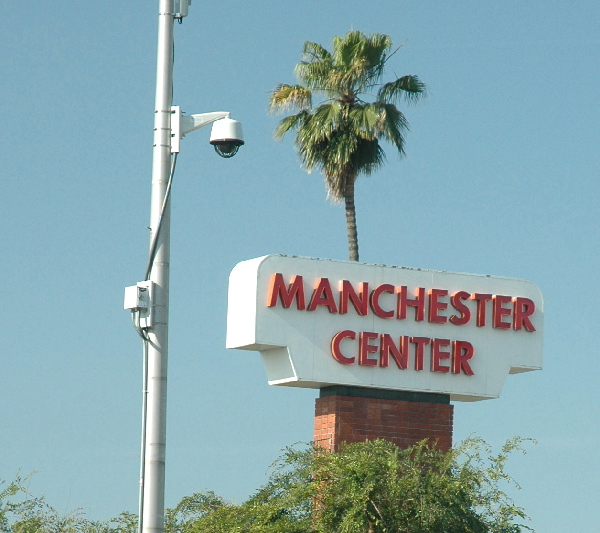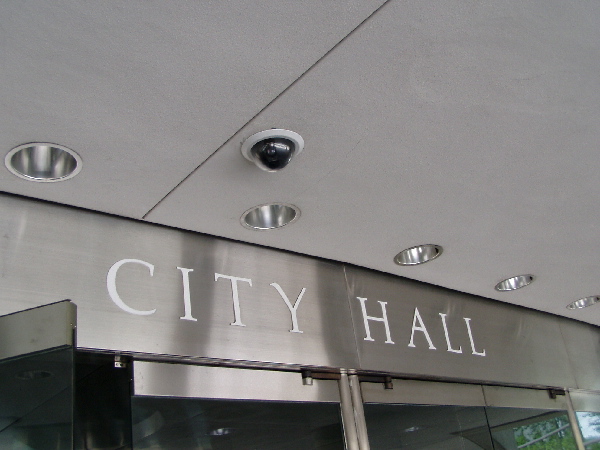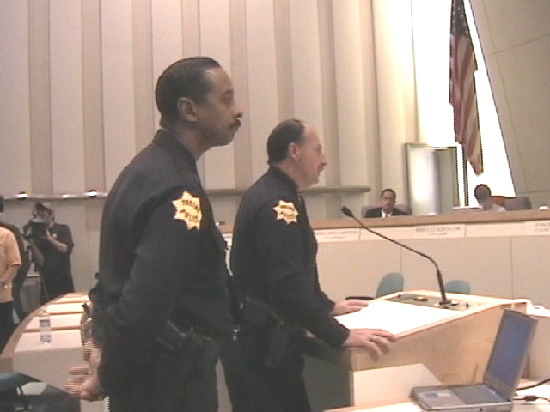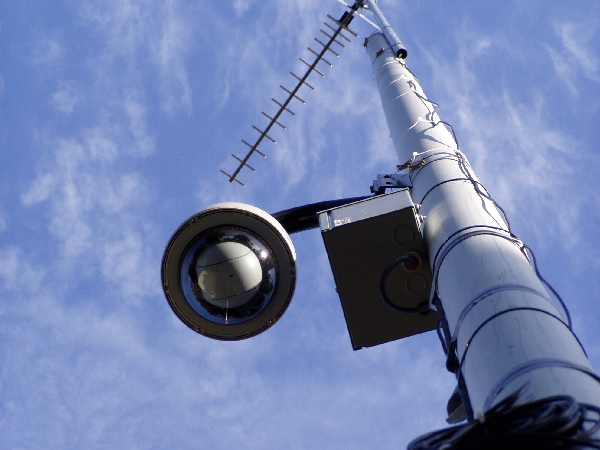This Area is Under Surveillance
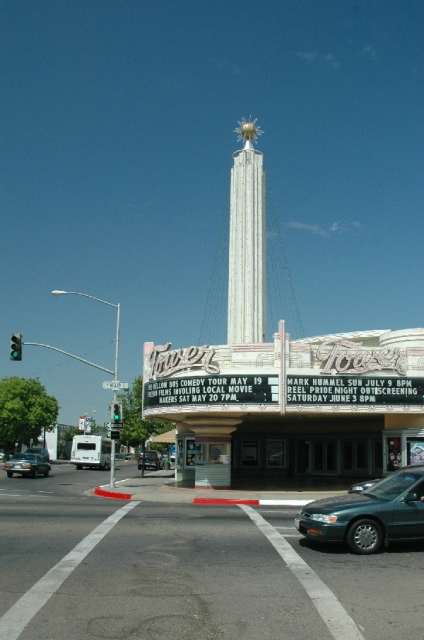
This Area is Under Surveillance
By Mike Rhodes
Fresno is on the verge of installing and implementing one of the most sophisticated video surveillance systems in the country. Fresno Police Department Captain Al Maroney says "I hope to have at least a ‘seed’ system operational before the end of calendar year 2006." The system Maroney is talking about would vastly increase video surveillance in this community with at least 256 cameras and the ability to connect with private sector cameras in locations like River Park, Fashion Fair, convenience stores, and other local businesses. A large part of the funding for this project will come from a grant from the Department of Homeland Security, administered by the County of Fresno.
The Fresno Police Department (FPD) plans to spend over a million dollars in the first phase of the project. Their vision is to have state of the art high resolution cameras interconnected with video surveillance cameras in businesses all fed into a central downtown location. When a crime takes place and a 911 call is received a camera in the area of the crime will be put on alert. The signal from that camera will be sent directly to squad cars in the crime scene area. The camera can be zoomed in and focused on the activity taking place. The responding officer can see, in real time, what lies ahead. Meanwhile, the entire incident is being recorded on a hard drive that stores the information at police headquarters.
The system the FPD wants to purchase is called Endura and is being manufactured by Pelco, one of the largest manufacturers of video surveillance equipment in the world. Pelco’s world headquarters are located in Clovis. The pilot cameras in this system are currently being installed. You can see them at the Fresno Area Express bus hub at Manchester Center. Maroney is using this installation to work the bugs out of the system. The first complete system will likely be in the Tower District and downtown Fresno.
If Fresno gets the Endura system, it will be only the second installation of this technologically advanced system in the US. The first Endura system was installed in New York City. The system has the capacity to network hundreds of analog cameras, convert the video to a digital signal, and store the data for future use. Maroney says "we are not planning on having someone watching each of these monitors for a crime in progress." The police will utilize the cameras if there is a crime in progress, like in the case of a 911 call, but most of the time they will save the video and only retrieve it if there is a criminal investigation.
But, the technology has its critics. The American Civil Liberties Union is opposed to video surveillance and doesn’t believe the technology has a place in our society. Mark Schlosberg, police policy director of the ACLU in Northern California, says "Public video surveillance systems are incredibly intrusive and sacrifice valuable privacy rights without any improvement in public safety. Study after study shows that blanketing large areas with surveillance cameras does not reduce crime. Scarce tax dollars are better spent on community policing programs rather than expensive big brother schemes." Studies in Europe, where video surveillance technology is widely used, seem to back up Schlosberg’s contention that it does not stop crime. A 2005 British study showed video surveillance didn’t reduce crime or make people feel safer. A BBC article about that study is available here: http://news.bbc.co.uk/1/hi/england/leicestershire/4294693.stm . An earlier study (see http://news.bbc.co.uk/1/hi/uk/2192911.stm ) also showed that video surveillance is "not a crime deterrent."
Deirdre K. Mulligan, Director of the Samuelson Law (Technology & Public Policy Clinic) at the UC Berkeley’s Boalt Hall, is not entirely opposed to utilizing the technology. Mulligan says "Video Surveillance Technology, accompanied by appropriate policies, and installed after a thorough consideration of whether the technology is well suited to addressing the problem and capable of doing so in a manner that is fiscally sound and consistent with protections for civil liberties and civil rights may be a useful tool in a very limited set of circumstances." Mulligan continues, "unfortunately, cities like Fresno are adopting surveillance systems without any form of public oversight and little attention to whether the technology is likely to address the problem it's being thrown at."
The Fresno Police Department has already begun the permanent installation of video cameras at several locations. This has been done without a community dialog about the need for the equipment or a discussion about alternatives that might be available. Mulligan says "It is unconscionable to adopt a system like this without public review and without policies to protect the rights of citizens. Policies to protect individual rights, and limit and monitor system use must be in place to guide the design, implementation, use and oversight of the system."
The FPD does not have a policy manual that would determine who has access to the recorded images, how long the images are stored, prevent racial profiling, or other abuses of the system. The FPD is not alone. Fresno City Hall, which has 15 cameras watching people at City Hall does not have a policy either. Brian Terhaar, Fresno City Hall Site Security Supervisor, who gave me a tour of their system says his training includes telling operators to "imagine your grandmother is standing over your shoulder." In other words, don’t use the pan, tilt, and zoom features to zero in on attractive members of the opposite sex.
The Fresno Unified School District (FUSD) has over 100 cameras on at least 15 campuses and they don’t have a policy manual to protect students from the misuse of the video surveillance equipment either. Without guidelines for the use of video surveillance equipment at FUSD, it is unclear whether anyone could be held accountable and disciplined if they misused the equipment.
As the technological capabilities for video surveillance expands it will become even more important to have guidelines. Will Fresno City Hall, FUSD, or the FPD be allowed to buy and install video surveillance equipment that can look for weapons under your clothes? How about equipment that will allow the police to see through the walls of your house? There is biometric software that looks for suspicious patterns of behavior. This biometric technology will also identify "persons of interest" that the police are looking for. Should public agencies be allowed to use this technology, just because it is available and could aid in crime prevention? A policy manual, written with public input, would answer these questions.
Without safeguards in place, problems can and do occur. For example, in Washington DC, a police employee monitoring video surveillance cameras, recorded video of a man entering a gay bar. Using police computers, the employee researched the license number of the car the man was driving and used the information to extort money from him. In London an operator was caught selling voyeuristic videos from the cameras he was monitoring.
According to Deirdre Mulligan "at the very least the Department of Homeland Security (DHS) should be requiring localities using DHS money to install and deploy these systems to complete a ‘Privacy Impact Assessment’ as federal agencies must when adopting new systems to handle personal information. The lack of transparency about new police and intelligence systems and tactics, combined with a lack of careful consideration of the utility and costs of the systems is a recipe for fiscal irresponsibility and substantial incursions on individual rights and democratic values."
"They that can give up essential liberty to obtain a little temporary safety deserve neither liberty nor safety." Benjamin Franklin
With the crime rate going down and social services being cut back, some Fresnan’s wonder if this is the most effective use of public money. Would increasing the number of officers on the street be more successful in preventing crime than video surveillance? In a recent discussion about this issue on a Tower District listserv several writers said they were uncomfortable with the proposal to be monitored when they were in the area. One writer asked why there weren’t more bicycle patrols and officers in the neighborhood on foot. Other writers proposed boycotting the Tower District if the video surveillance cameras were installed.
Catherine Campbell, a local civil rights attorney and one of the writers on the Tower District listserv, wrote that the negative reaction to video surveillance cameras "is an overreaction borne of our experience of hyper-illegal surveillance by the FBI and other law enforcement agencies over the years. Many stores have video cameras to help them protect their businesses and we hardly notice it and are grateful they were there when they help in the apprehension of someone who has stolen property or injured someone." She continued, "The public sidewalks are free space for us and for the police too; we don’t have a right to be private when we’re walking the street, it’s simply not conduct that is protected. If the cameras came into our homes, that would be an entirely different issue but the FPD is not proposing that."
While Catherine Campbell and Captain Maroney seem to agree that the public have few privacy rights in public spaces, not everyone thinks that is true. A report, just released by The Constitution Project, says that "Privacy and anonymity rights are clearly imperiled by public video surveillance systems, if misused. Cameras could routinely capture footage of individuals engaging in activities in which most expect anonymity, such as entering an Alcoholics Anonymous meeting, a psychiatrist ’s office, or the headquarters of a fringe religious or cultural group. Similarly, cameras might capture things most people would seek to keep private, such as the label on a vial purchased at a drug store or an intimate conversation between two family members on a stroll."
Freedom of speech and association could also be at risk. If video surveillance cameras, monitored by armed government agents, are able to keep a record of who you talk to, what you say, and what you read, it could have a "chilling" effect on your free speech rights.
In weighing the balance between privacy rights and the desire for greater security, Campbell concludes "personal discomfort with police surveillance of this sort is warranted, however, not because it violates our rights but because it tells us that the police cannot handle our streets by being personally present. Video surveillance is an alienating form of protection, one that creates an ‘us vs. them’ mentality and is a very poor substitute for the community presence of known and respected officers."
In January 2006 captain Al Maroney and police chief Jerry Dyer made a presentation about the video surveillance project before the Fresno City Council. Council president Jerry Duncan introduced the presentation by saying that the purpose of the hearing was to bring the council up to speed on the project. Duncan made it clear that there was no opportunity at the January meeting for public comment on this issue. Duncan said "it is my expectation that in the near future we will have a more formal process for adoption and action and at that point we will hopefully get feedback from the public from those who think this is a good idea and those who think it is not a good idea." That public hearing has now been scheduled - it will take place on Wednesday, June 14th at 6 PM at Bullard High School.
In an email to me about this hearing, Duncan wrote "we are having our budget hearings outside of City Hall this year, in the evenings, to make it easier for people to attend if they are interested. During that meeting FPD will present their plan for any dollars requested in the new budget (including surveillance cameras) and there will be a chance for the public to speak and the Council to ask questions. So the budget process is very much a public hearing and since that is the time funding is requested, a very appropriate venue."
With the FPD moving forward with installing and testing video surveillance equipment, phase one of the project scheduled for completion by the end of the year, and a June 14th meeting about this issue before the City Council, the public will have to get engaged if they have concerns and want to have input into the process.
For more information about video surveillance, contact:
The Constitution Project
1025 Vermont Avenue, NW
Third Floor
Washington DC, 20005
202 580-6920
info@constitutionproject.org
www.constitutionproject.org
American Civil Liberties Union, Northern California
1663 Mission Street - Suite 460
San Francisco CA 94103
415 621-2493
http://www.aclunc.org/
Get Involved
If you'd like to help with maintaining or developing the website, contact us.
Publish
Publish your stories and upcoming events on Indybay.


